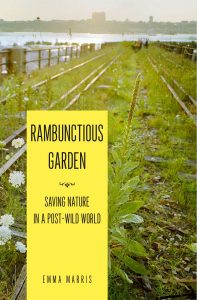Novel Ideas

THE WILDFLOWER CENTER CHAMPIONS NATIVE PLANTS, and as a member of the Center’s Department of Ecological Research and Design, my job primarily focuses on restoring ecosystem services within urban environments. To put it bluntly, I love creating prairies in the shadows of skyscrapers. But … there is a serious debate among ecologists and designers regarding the trajectory of conservation and, more specifically, the utilization of novel ecosystems — or ecosystems that, “by virtue of human influence, differ from those that prevailed historically” (per Hobbs et al.).
Emma Marris’ “Rambunctious Garden: Saving Nature in a Post-Wild World” is a thoroughly interesting read that questions traditional restoration, conservation and preservation strategies by embracing the inclusion of more radical interventions within degraded ecosystems. At a minimum, the book provides readers with a stunning array of examples where humans have taken the role of active agent in the landscape where they assist floral and faunal migrations and embrace invasive plant communities. Many reviewers, such as George Wuerthner of The Wildlife News, have pointed out serious issues with such activities because in doing so we treat ecosystems as a “resource cookie jar for humans” and promote a general ignorance of precisely how specific ecosystems work causing further damage to threatened systems that are already barely holding on.
Marris makes claims that the idea of “pristine wilderness” is thoroughly outdated and that unmanaged “ecosystems that look the most pristine are perhaps the least likely to truly be wild,” and provides insights from ecologists that “there really isn’t one unique state of natural conditions for any given landscape. What is more realistic is to set a range of natural conditions.” From her perspective, the concept of preservation is no longer effective as a large-scale strategy because the baselines being used for restoration purposes aren’t necessarily accurate. Rather, she sees them as snapshots from the past that drive conservation targets simply because “there is a lingering feeling that things were somehow right, back then, that some fundamental state of harmony existed between humans and the rest of nature.”
What makes this book so fascinating to me is that it immerses the reader into areas of debate that are being exacerbated by the absolutely real effects of climate change. Much of my group’s work at the Wildflower Center involves creating and restoring native plant communities deep within urban matrices. We carry out months of research to determine what the pre-existing conditions of the site likely were (including soils, plants, and hydrology) and try to aim for that target, but we also have to layer on top of that design performance goals (heat island mitigation, carbon sequestration, pollinator habitat, water retention, etc.), as well as the all-important charge of integrating people with the landscape.
Can we argue that the designs we construct are perfect recreations of the past? Likely not. One could argue that our efforts fit within Marris’ definition of novel ecosystems, but where we differ from some of Marris’ subjects is that all of our choices are driven by ecosystem function and climax species communities that we know will unquestionably benefit people and fauna without damaging any healthy neighboring natural areas, and we embrace the maintenance of these landscapes as a means to promote education through avenues such as biology, ecology and landscape architecture.
Ultimately, as a practitioner of ecological restoration, I appreciate the innovative approaches that are discussed in the book and think that, given the threats to our environment, we will have to examine increasingly an adaptive approach to conservation that might make some traditionalists uneasy. However, these “out of the box” methodologies must be backed by scientific data that proves, as demonstrably as possible, that they won’t contribute to greater harm.
We cannot deny that the increasing human population on earth will continue to dramatically affect our environment, so we must determine how to mitigate that impact. Check out Marris’ book with a critical eye and decide for yourself how to be part of the solution.

